
Your bathtub, washbasin, mirror, and toilet may be spick and span. But there are several bathroom essentials that you are possibly neglecting.
Be truthful: When did you last look at your exhaust fan? And how many months ago did you clear out the expired drugs from your medicine cabinet? Have you gotten rid of all the rusted razor blades in your bathroom?
Here’s a comprehensive checklist that will help you get rid of all the unpleasant microbes lurking in your bathroom.
- How Often Should You Clean Bath Mats
- How Often Should You Clean Bath Towels
- How Often Should You Clean Shower Heads
- How Often Should You Clean Shower Baths/Baths
- How Often Should You Clean Basin
- How Often Should You Clean Toilet
- How Often Should You Clean Toilet Brush
- How Often Should You Clean Bathroom Floor
- How Often Should You Clean Children's Bath Toys
- How Often Should You Clean Loofahs/Body Sponges
- How Often Should You Clean Your Hairbrush & Toothbrush
- Tips on Giving Your Bathroom a Quick Clean
- How to Give Your Bathroom a Deep Clean?
- Conclusion
Navigate to any section of this post by clicking on the links above.
1. How Often Should You Clean Bath Mats
Stepping on a warm bath mat after a relaxing shower is such a pleasant experience. But have you ever wondered that a bath mat can be a cesspool of harmful bacteria?
Bath mats harbour serious gunk and grime. The warm and moist environment in the bathroom provides a natural breeding ground for mildew, mould, and fungi.
You’ll need to clean your mat once a week since it’s wet most of the time. And if the traffic is high, you’ll need to clean it twice a week. Cleaning the mat is simple. Just launder it in a washing machine.
Replace a bath mat as soon as there’s any sign of wear and tear. Mats with rubber backing last much longer. But replace the mat when the backing starts to deteriorate.
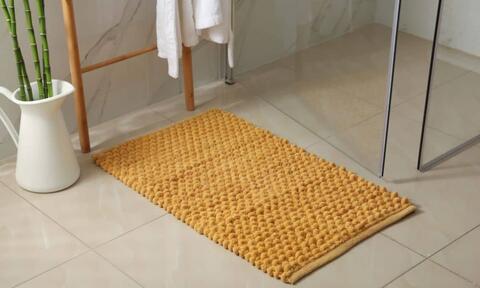
2. How Often Should You Clean Bath Towels
After every use, hang a bath towel on a clothesline or a heated towel rail so that it dries fast. The combination of germs, dead skin cells, and moisture makes for a dreadful breeding ground, which would be the last thing you’d want to use on your freshly showered body.
Keep your bath towel hygienic by washing it after every 3–4 uses. Use a mild detergent and wash in warm or hot water as the care label permits to effectively eliminate harmful bacteria and moulds.
Bath towels that are washed thoroughly and frequently last longer. Replace a bath towel the moment it loses absorbency, or it smells bad even after washing.
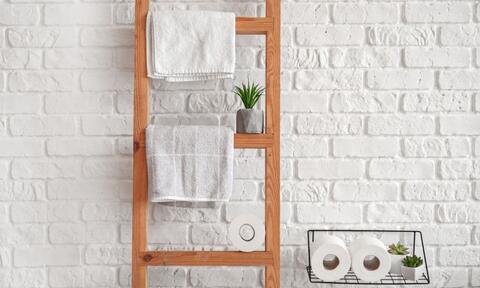
3. How Often Should You Clean Shower Heads
Unlike a dirty bathtub, a grimy shower head does not show up readily because it tends to be relatively clean on the outside but dirty on the inside. The hot, humid environment inside a shower head is the perfect breeding ground for germs and mould.
Also, a build-up of organic matter and mineral residue over time can clog the tiny holes, preventing a steady flow of water. Your shower head will need a good soak when you notice a sudden drop in water pressure or erratic spray patterns.
Ideally, you should clean the shower head once a month with vinegar to get rid of the mineral residue. Replace the shower head once it shows signs of rust.

4. How Often Should You Clean Baths/Shower Baths
A clean bath/shower bath is indispensable to de-stress. It’s so much easier to relax and unwind when the space is clean and tidy. On the contrary, a warm soak/shower in a dirty space is hardly relaxing.
Give the showering area, shower enclosure, and bathtub a good scrub once a week. Spray a mild bathroom cleaner and allow it to soak for a few minutes. Scrub with a cleaning brush and wipe the surface with a clean towel after you finish scrubbing.
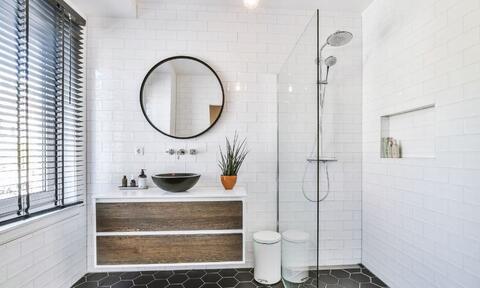
5. How Often Should You Clean Basin
The basin is the most used item in a bathroom. A lot of hand washing, brushing of teeth, and applying/removing makeup happens here.
Germs typically live on surfaces for one to seven days. Hence, you’ll need to clean the basin at least once a week. Remove everything from the basin top and clean the counter and wipe it dry.
But clean the basin and mirror twice a week if they are located close to the toilet. And if the traffic is high, it’s best to wipe the mirror and basin with a dry towel every day.
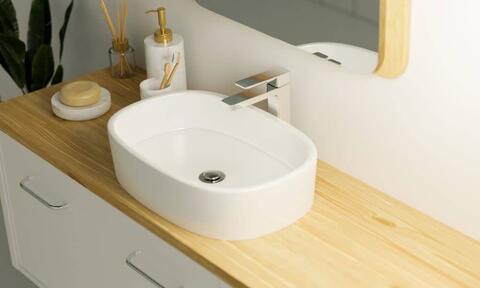
6. How Often Should You Clean Toilet
E.coli, bacteria that live in human intestines, can thrive within six feet of the toilet. While most strains of these bacteria are harmless, some strains can cause severe food poisoning.
Keeping the toilet clean can prevent microbes like e.coli from spreading and causing sickness. Disinfect the toilet at least twice a week to keep microbes at bay.
Apply the toilet cleaner liquid to the toilet bowl and the exterior of the toilet. Allow it to stand for a few minutes. Scrub the surface with a scrub brush and rinse with water. Flush the toilet and wipe the surface with a dry towel.
Pro tips: it’s recommended to close the toilet lid before flushing, it will prevent aerosolised microbes from being sprinkled throughout your bathroom.
7. How Often Should You Clean Toilet Brush
You can easily overlook both the toilet brush and the container it sits in if you’re not careful. A toilet brush is germy most of the time because it’s used for the toughest cleaning task in the bathroom.
It’s recommended to wash the toilet brush once a week. Fill the toilet brush container with hot, soapy water after every use. Swish the brush around and pour the water down the toilet bowl.
Before placing the toilet brush in the container, spray both items with a disinfectant and rinse them with clean water.
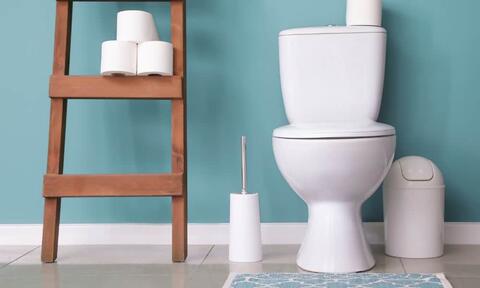
8. How Often Should You Clean Bathroom Floor
An unclean bathroom floor not only looks dirty but also poses a health risk, as germs, mould, and scum build up quickly. Clean the bathroom floor once a week as part of your regular cleaning routine.
The most effective way of cleaning the bathroom floor is to sweep up the loose dirt and debris and empty them into a trash bin. Then, clean stains and stuck-on dirt with a mop dipped in hot water. Use a floor cleaner if needed.
Once the floor is dry, vacuum it to clear any dust you missed.
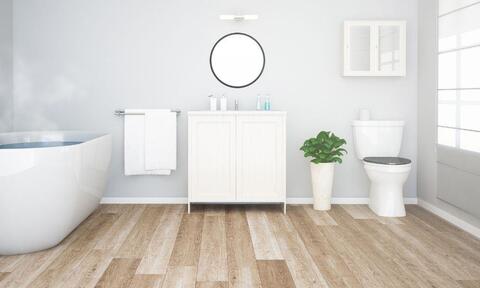
9. How Often Should You Clean Children’s Bath Toys
It’s so much fun to squirt water through the tiny holes in rubber toys. However, moisture can get stuck inside, and mould can proliferate. You can prevent this by dabbing a bit of hot glue to seal the holes.
You may assume that these toys get cleaned automatically during bath time. But they don’t. Since bath toys can harbour mould, mildew, and germs inside them, they need to be cleaned once a week.
Soak the toys in a bucket filled with equal parts of warm water and vinegar. Let it stand for an hour. (Use bleach for a deeper clean.)
Air dry the toys after rinsing them with tap water. Run the extractor fan for a few minutes so that the toys dry faster.
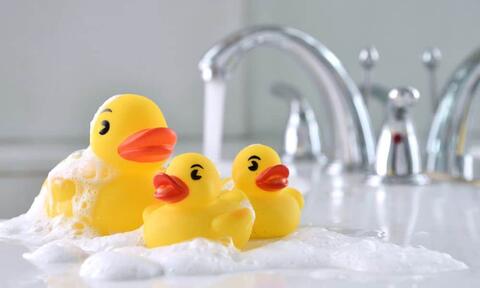
10. How Often Should You Clean Loofahs/Body Sponges
Loofahs and body sponges are a fertile breeding ground for yeast, mould, and bacteria. Since they scrub off an enormous quantity of dead skin cells with every wash, they need frequent cleaning.
You’ll need to replace natural loofahs/sponges every three to four weeks. Plastic loofahs/sponges, which are a great alternative, last longer. You’ll still need to replace them every two months.
Cleaning is easy. Soak a loofah/body sponge in a dilute bleach solution for a few minutes and rinse it thoroughly.
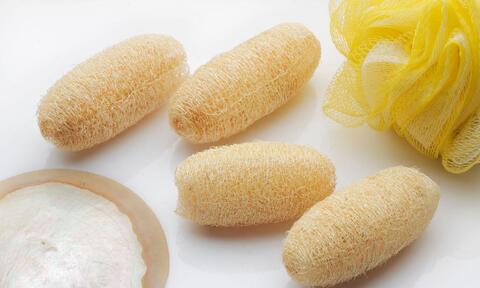
11. How Often Should You Clean Your Hairbrush & Toothbrush
A hairbrush harbours not just hair. It also holds other minute debris such as dust, oils, hair products, and dust mites. You certainly wouldn’t want all these undesirable particles on your clean hair.
So clean your hairbrush once a week by adding 4 to 5 drops of shampoo to warm water and swirling the mixture until suds form. Immerse the bristles in the water and scrub near the bottom of the bristles with a clean toothbrush.
Rinse the hairbrush with fresh water and shake it dry. Wrap it in a clean towel overnight.
Your toothbrush needs a lot more care than your hairbrush. Rinse it thoroughly with hot water after each use. And replace your toothbrush after 3 months or sooner if the bristles are damaged.
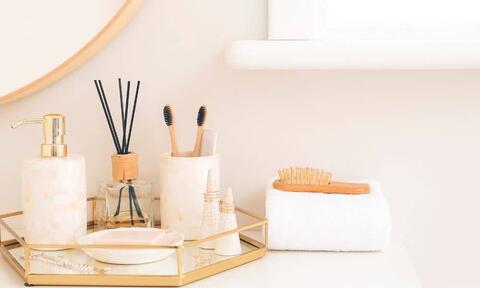
Tips on Giving Your Bathroom a Quick Clean
Getting rid of soap scum and dirt from shower enclosures, bathtubs, sinks, toilets, and other surfaces can be time-consuming. But if you follow the steps listed below, you can clean your bathroom fast:
- Clear all items from their usual places.
- Dust, sweep, and vacuum.
- Apply cleaning liquid to the showering area and bathtub.
- Clean all the other surfaces.
- Mix the bathroom floor cleaner with water.
- Clean the showering area and the bathtub.
- Clean the vanity unit.
- Clean the toilet and toilet brush.
- Mop the bathroom floor.
How to Give Your Bathroom a Deep Clean?
A deep clean will leave your bathroom shiny and fresh. In a quick clean, you clean just the main bathroom accessories. But a deep clean is different because you will have to clean all the hidden corners, as well.
A mixture of baking soda and white vinegar is an effective deep cleaning solution. With this environment-friendly mixture, you can deep clean your bathroom and get rid of the most stubborn stains on the mirror, glass door, floor, toilet, and washbasin.
Summing It Up
Your bathroom essentials need to be cleaned at least once a week. But wipe the toilet and sink with a clean towel once in two days, as these are vulnerable breeding spots in which the dangerous e.coli bacteria thrive.
You’ll also need to take special care of personal grooming items such as hairbrushes, toothbrushes, towels, and body sponges.